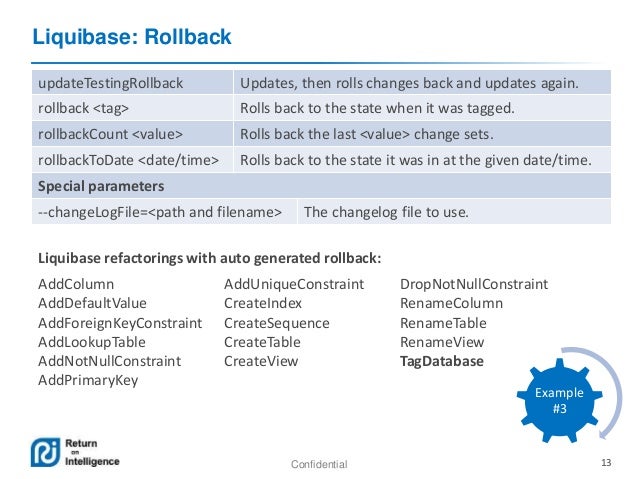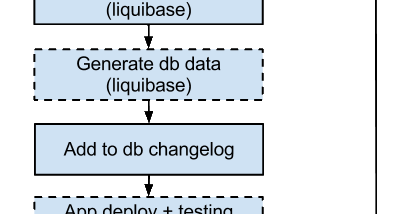Liquibase Auto Generated Ids Foreign Keys
This chapter explains the Liquibase feature in SQLcl. It has the following topics:
2.1 About Liquibase
Liquibase is an open-source database-independent library for tracking, managing and applying database schema changes. For an understanding of the major concepts in Liquibase, see Major Concepts.
In SQLcl, you can now execute commands to generate a changelog for a single object or for a full schema (changeset and changelogs). You can process these objects manually using SQLcl or through any of the traditional Liquibase interfaces.
ALTER TABLE `parent` ADD FOREIGN KEY (`id`) REFERENCES `child` (`parentid`); As you can see the table parent has an auto-incremented primary key 'id', which is also being used as a foreign key for the child table. Now I want to insert a record in the parent table, like this: INSERT INTO parent SET DATA='abc'; And it fails with error.
I was trying to create a new object with multicolumn primary key formed by a foreign key and a self-generated field and I found this error: Ids can not be autogenerated for entities with multipart keys. For now, and although not the most appropriate, I will change the key but the question is. Autogenerate UUID in Liquibase - Mysql MariaDB. Ask Question. But this is not even treating the valueComputed property in the corresponding query generated. Can anyone help please. NULL, CONSTRAINT PKQUIZQUESTION PRIMARY KEY (id), CONSTRAINT fkquizquestionquestionid FOREIGN KEY (questionid) REFERENCES question(id), CONSTRAINT fk. For successful removal of that foreign keys is required to drop indexes first. But MySQL support session option named FOREIGNKEYCHECKS. If value of this option is 1 MySQL ignores foreign key constraints on DML and DDL operations. This patch modifies liquibase behavior for dropping all database objects. With the IBM® Data Server Driver for JDBC and SQLJ, you can use JDBC 3.0 methods to retrieve the keys that are automatically generated when you execute an INSERT statement. To retrieve automatically generated keys that are generated by an INSERT statement, you need to perform these steps.
With the Liquibase feature in SQLcl, you can:
- Generate and execute single object changelogs
- Generate and execute schema changesets with object dependencies
- Automatically sort a changeset during creation based on object dependencies
- Record all SQL statements for changeset or changelog execution, as it is generated
- Provide full rollback support for changesets and changelogs automatically
2.2 Requirements for Using Liquibase
The two important aspects for using Liquibase are capturing and deploying objects in an Oracle database.
Capture Objects
To capture an object or a schema, you must have SQLcl 19.2 or later installed.
In this release, you can only capture objects from the schema you are connected to in SQLcl. You also need write permission on the directory in which you save the files.
If you are capturing an entire schema, the user you are connected to must have the privilege to create a table. The DATABASECHANGELOG_EXPORT table is created internally to gather object details and sort them correctly. The created object is automatically excluded from the capture process and destroyed upon capture completion.
Deploy Objects
Liquibase uses the DATABASECHANGELOG table to track the changesets that have been run. The DATABASECHANGELOGLOCK table ensures that only one instance of Liquibase is running at a time. The DATABASECHANGELOG_EXPORT table tracks the object state and the SQL statements executed during deployment.
SQLcl
Deploying changes to any database through SQLcl requires the 19.2 release or later and the privilege to create a table. You must have necessary permissions to create any object type through the change that you are deploying.
Liquibase
If you use Liquibase directly to deploy changesets, you need to have:
- the extension installed in your Liquibase environment. Add the
oracle-liquibase.jarfile inliquibase/lib/ext. - the privilege to create a table.
- the extension installed in your Liquibase environment. Add the
2.3 Supported Types
DDL types use create or replace syntax, however, a snapshot of the object is taken before applying the change so automatic rollback to the last known state is supported. SXML types support automatic alter generation with automatic rollback support.
DDL types have their own change type.
- CONSTRAINT
- DIMENSION
- FUNCTION
- OBJECT_GRANT
- PACKAGE_BODY
- PACKAGE_SPEC
- PROCEDURE
- PUBLIC_SYNONYM
- REF_CONSTRAINT
- SYNONYM
- TYPE BODY
- TYPE SPEC
Liquibase Auto Generated Ids Foreign Keys West
SXML types share the SXML change type.
- AQ_QUEUE
- AQ_QUEUE_TABLE
- AQ_TRANSFORM MATERIALIZED_VIEW
- ASSOCIATION
- AUDIT
- AUDIT_OBJ
- CLUSTER
- CONTEXT
- DB_LINK
- DEFAULT_ROLE
- FGA_POLICY
- JOB
- LIBRARY
- MATERIALIZED_VIEW_LOG
- OPERATOR
- PROFILE
- PROXY
- REFRESH_GROUP
- RESOURCE_COST
- RLS_CONTEXT
- RLS_GROUP
- RMGR_CONSUMER_GROUP
- RMGR_INTITIAL_CONSUMER_GROUP
- RMGR_PLAN
- RMGR_PLAN_DIRECTIVE
- ROLE
- ROLLBACK_SEGMENT
- SEQUENCE
- TABLE
- TABLESPACE
- TRIGGER XS_ACL
- TRUSTED_DB_LINK
- USER
- VIEW
- XMLSCHEMA
- XS_ACL_PARAM INDEX
- XS_DATA_SECURITY
- XS_ROLE
- XS_ROLESET
- XS_ROLE_GRANT
- XS_SECURITY_CLASS
- XS_USER
2.4 Supported Liquibase Commands in SQLcl
You can invoke the Liquibase commands in SQLcl with liquibase or lb. To display a list of all available commands, execute liquibase or lb with no arguments.
The different commands are:
liquibase(lb) genobject <object_type> <object_name>
Captures a single object using the current connection in SQLcl. It creates an xml file in the current working directory named <object name>_<object type>.xml.
Available Parameters:
| Name | Description | Required |
|---|---|---|
| Object type | Type of object (this is an Oracle type) | Yes |
| Object name | Name of object | Yes |
Example:
liquibase(lb) genschema
Captures the entire schema that the user is connected to in SQLcl. It creates an xml file in the current working directory for each object in the schema, and a controller.xml file. The controller file is a change log that includes all files in the proper order to allow the schema to be deployed correctly.
Available Parameters:
| Name | Description | Required |
|---|---|---|
| Public synonym | Capture public synonyms. Default is false. | No |
| Grants | Capture grants. Default is false. | No |
Example:
liquibase(lb) gencontrolfile
Creates an empty changelog, master.xml, with a placeholder to include files in the current working directory. You can use this command when you are creating you own changelog with custom changeset inclusions.
Liquibase Auto Generated Ids Foreign Keys 2017
liquibase(lb) update <CHANGE LOG> {include schema}
Applies the specified change log using the current connection. You can choose to have the schema included in the DDL by passing in TRUE for include schema. The default value is FALSE.
liquibase(lb) updatesql <CHANGE LOG> {include schema}
Generates and renders to the screen the SQL statements that would be applied for a specific change log. You can choose to have the schema included in the DDL by passing in TRUE for include schema. The default value is FALSE.
liquibase(lb) rollback <CHANGE LOG> <COUNT>
Rolls back changes starting from the last change applied using the input change log. The count can be higher than the changes in the change log. 999 is the maximum size and will roll back all the changes.

liquibase(lb) diff <DEST URL> <DEST USER> <DEST PASS> {report}
Displays differences between the current connection and the specified database. When the report is true, the output will be in the form of a text report. When the report is false, which is the default, the output will be in the form of a change log.
The destination URL format is HOST:PORT:SID or HOST:PORT/SERVICE.
liquibase(lb) status <CHANGE LOG>
Checks the status of the change log using the current connection. This shows if the change log has been applied and the result of the change log.
liquibase(lb) validate <CHANGE LOG>
Verifies if the change log is syntactically correct.
liquibase(lb) changelogsync <CHANGE LOG>
Writes the SQL statements to mark all changes in the change log as executed in the database to a file.
liquibase(lb) listlocks <CHANGE LOG>
Lists who currently has locks on the database change log.
liquibase(lb) releaselocks <CHANGE LOG>
Releases all locks on the database change log.
liquibase(lb) clearchecksums <CHANGE LOG>
Removes the current checksums from the database. In the next run, the checksums will be recomputed.
liquibase(lb) help <COMMAND>
Lists the available Liquibase commands. Type a command with no options for help on a specific command.
2.5 ChangeSets
The following table lists the changeSets and provides a description for each of them. /generate-private-key-from-cer-openssl.html. To learn more about changeSets, see <changeSet> tag.
| ChangeSet | Description |
|---|---|
| CreateOracleConstraint | Creates a constraint from SQL. |
| CreateOracleFunction | Creates a function from SQL. |
| CreateOracleGrant | Creates a grant from SQL. |
| CreateOraclePackageBody | Creates a package body from SQL. |
| CreateOraclePackageSpec | Creates a package specification from SQL. |
| CreateOracleProcedure | Creates a procedure from SQL. |
| CreateOraclePublicSynonym | Creates a public synonym from SQL. |
| CreateOracleRefConstraint | Creates a referential constraint from SQL. |
| CreateOracleSynonym | Creates a synonym from SQL. |
| CreateOracleTrigger | Creates a trigger from SQL. |
| CreateOracleTypeBody | Creates a type body from SQL. |
| CreateOracleTypeSpec | Creates a type spec from SQL. |
| CreateSxmlObject | Creates a function from SQL. |
| DropOracleConstraint | Drops a constraint. |
| DropOracleFunction | Drops a function. |
| DropOracleGrant | Drops a grant. |
| DropOraclePackageBody | Drops a package body. |
| DropOraclePackageSpec | Drops a package specification. |
| DropOracleProcedure | Drops a procedure. |
| DropOracleRefConstraint | Drops a referential constraint. |
| DropOracleTrigger | Drops a trigger. |
| DropOracleTypeBody | Drops a type body. |
| DropOracleTypeSpec | Drops a type specification. |
| DropOracleSynonym | Drops a synonym. |
| DropSxmlObject | Drops an SXML object. If the object was created through createSxmlObject, this rolls back the object to the last state. If not created, the object is just dropped. This is primarily used internally for SXML object handling. |
| RunOracleScript | Runs an Oracle script. |
2.6 Examples Using Liquibase
Some examples for using the Liquibase feature in SQLcl are:

Capture and Deploy an Object
To deploy the emp table from hr to hr2:
- Connect to hr.
- Capture the object.
- Connect to the other user.
- Ensure the object does not already exist.
- Create the object in the current schema.
Note:
As the schema name has changed, you must set include schema tofalseor it will try and create the object in the HR schema. - Verify the object was created.
Liquibase Auto Generated Ids Foreign Keys Download
Capture and Deploy a Schema
Snipe-it generate app key windows. To capture the HR schema and reproduce it in the HR2 schema:
sql.exe hr/hr@pdb1
Capture and Deploy a Schema and then Upgrade it and Redeploy
- Migrate the HR schema to the HR2 schema, then modify the HR schema and update HR2.
- Modify the HR Schema.
- Make a change to the v2 directory.
- Export v2 of the HR schema.
- To import v1, change back to the v1 directory and connect as HR2.
- Now import the capture into the HR2 schema.
- Check a table to verify.
- Switch to v2 and import the capture.
- Verify that you are on v2.